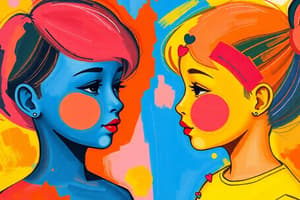Podcast
Questions and Answers
Historically, the generally accepted rule was pink for ______ and blue for girls.
Historically, the generally accepted rule was pink for ______ and blue for girls.
boys
The change to pink for girls and blue for boys happened only after World War ______.
The change to pink for girls and blue for boys happened only after World War ______.
II
Alison Carr suggests that when buying toys for a child, we are influenced by ______.
Alison Carr suggests that when buying toys for a child, we are influenced by ______.
stereotypes
89% of girls' toys are ______.
89% of girls' toys are ______.
Most girls' toys are centered around dolls and ______.
Most girls' toys are centered around dolls and ______.
South Korean photographer Yong Mi ______ created a project centered around children and their color-coded belongings.
South Korean photographer Yong Mi ______ created a project centered around children and their color-coded belongings.
The toys children play with can influence their ______ and future job choices.
The toys children play with can influence their ______ and future job choices.
If girls don't have access to construction toys or ______ and scientific toys, they may think those fields aren't for them.
If girls don't have access to construction toys or ______ and scientific toys, they may think those fields aren't for them.
Flashcards are hidden until you start studying
Study Notes
Pink and Blue Stereotypes
- The pink for girls and blue for boys color scheme is a stereotype prevalent in children's clothing and toys.
- Contrary to common belief, historically, pink was considered a stronger color suitable for boys, and blue, a more delicate color, was seen as appropriate for girls.
- This dynamic shifted after World War II, when the idea of women being equal to men became more prominent, aligning pink with femininity.
- The pink and blue stereotype has been perpetuated by advertisers and has become ingrained in society, impacting everything from room colors and furniture to toys.
- Photographer Yong Mi Yoon's "Pink and Blue Project" highlights the pervasiveness of this stereotype through photographs showcasing children's rooms and belongings in these colors.
- Alison Carr from the Institute of Engineering and Technology argues that this stereotype limits children's opportunities, particularly girls.
Impacting Toy Choices and Career Paths
- 89% of girls' toys are pink, and a small percentage are related to science or math.
- Girls' toys often focus on dolls and dressing up, while boys' toys are more likely to be related to building and cars.
- The toys children play with influence their interests and even the jobs they choose later.
- Limited access to construction toys, mechanical toys, and scientific toys may lead girls to think these fields are not for them, making it less likely for them to study STEM subjects at school and university.
Studying That Suits You
Use AI to generate personalized quizzes and flashcards to suit your learning preferences.




